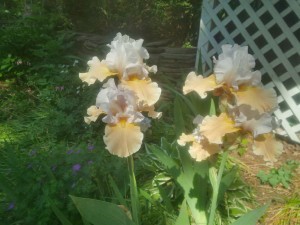 We are a long way from the ancient Greeks, but their gods and mythological heroes are still with us in many plant names. One of the loveliest ancient deities in our gardens is Iris, goddess of the rainbow, whose namesake flowers stand tall each spring.
We are a long way from the ancient Greeks, but their gods and mythological heroes are still with us in many plant names. One of the loveliest ancient deities in our gardens is Iris, goddess of the rainbow, whose namesake flowers stand tall each spring.
I can’t think of an ugly iris, but I am especially drawn to the tall bearded varieties that are descended from Iris germanica. Like the goddess, the species originated in the Mediterranean region. It has spread around the world, escaping cultivation and even naturalizing in some places.
But Iris germanica did not escape plant breeders, who have produced cultivated varieties in every color of the rainbow, not to mention sizes ranging from quite tall—up to 38 inches—to dwarfs that stand eight inches tall or sometimes even less. All sprout from the fleshy roots called rhizomes, bearing sword-shaped leaves and showy flower that are distinguished by “beards”. These are actually patches of fine, hairs that adorn the central “falls” or downward-facing petals and often contrast with the main flower colors.
Most of us know a bearded iris when we see one, but how many of us have given any thought to the scent of those gorgeous flowers? In the garden of my childhood home, my father grew a patch of pale blue bearded iris. They were lovely to look at, but their sweet scent was so pronounced that people commented on it. I have never found a variety quite like it, though I suspect that it might have originated in the nineteen twenties, around the time the house was built. Hundreds of iris varieties are commercially available now, but that one may well have been superseded by more recent cultivars.
I went on a search for bearded iris with strong scents and found that many varieties exude what vendors describe as “slight, sweet fragrance”, or just “sweet fragrance”. Many fewer bearded iris are described as having “pronounced fragrance”. When strong fragrance is present in a particular variety, it may be spicy, musky, fruity, or sweet. In fact, scientific papers have been written on the various chemical components responsible for iris fragrance. Suffice it to say that there are many.
I went on a hunt for especially fragrant iris varieties, hoping to find a pale blue one with pronounced fragrance. Catalog vendors like Schreiner’s Iris Gardens and Gardenia.net allow customers to search specifically for fragrance, but the results include many iris that have only “slight sweet scent”. Clearly a bit of digging is necessary to get to the most fragrant varieties.
I found one promising iris, ‘Sugar Blues’, with medium blue standards—the upright petals—and falls, coupled with white beards. The fragrance is listed as “pronounced”. ‘Sugar Blues’ is also a rebloomer, flowering in spring and again in fall, a trait that marks the variety as fairly recent in origin. The iris I remember from my childhood was a paler shade of blue, with orangish beards, so clearly ‘Sugar Blues’ is not an exact match with the plants that I remember.
‘Absolute Treasure’ is closer in color to what I remember, and is the right size. The catalog copy describes it as “a tall fragrant knockout”. It is not clear whether “knockout” refers to the color or the fragrance. It was introduced in 2006, so it is not the iris of my childhood, but might make a good substitute.
I made one last stop on my fragrant blue iris journey and that was at the American Iris Society, which maintains a registry of iris in commerce. Each year the Society also awards its Dykes Medal to one variety for overall appearance, hardiness and quality. Since the inception of the award in the 1930’s several blues have been honored, but the superlative-laden blurbs do not mention fragrance.
Since both ‘Sugar Blues’ and ‘Absolute Treasure’ come close to my iris of memory, I may order one of each to see which has the best fragrance. Even if neither is quite right, I will have gained two beautiful varieties.
And just maybe the bees will do their marvelous work, cross-pollinating my two blue newcomers and producing an offspring quite like that long ago fragrant blue iris. Stranger things have happened in my garden.
